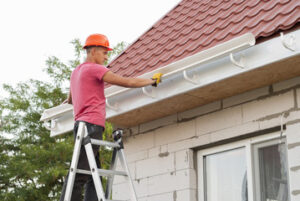Gutter Cleaning is a regular home maintenance task that protects the property from water damage, extends roof lifespan, and prevents pest infestations. The process requires climbing ladders, so prioritizing safety is key.

Clogged gutters fail to channel rainwater properly, leading to overflows and water damage to the facade and foundation. The damp environment also promotes the growth of mold and mildew. Contact Gutter Cleaning Charleston for professional help.
Gutter cleaning is an important step to ensure that rainwater flows freely away from the house, preventing damage to fascia boards, siding, roofing, and foundations. A clogged gutter is also an inviting environment for pest infestations, including mosquitoes, flies, and rodents.
If you are going to attempt the task yourself, be sure to take the necessary safety precautions. Ladders should be firmly secured and positioned in a stable position, and it is recommended that you wear protective eyewear to guard against dust particles that may fly off the work area. Additionally, be sure to choose an extension tube that is rated for wet or dry vacs and is long enough to reach the gutters. If using a garden hose, be sure to use a spray nozzle to direct the water flow into the gutters and rinse off any stuck-on grime.
A preferred method for gutter cleaning is to start at the downspout and carefully work your way along the gutter system, removing debris as you go. Alternatively, you can use a leaf blower to clear the gutters of large debris and then flush the system with water.
Once you have cleared the visible debris from the gutters, it is a good idea to test each downspout to make sure that it is flowing properly. A clogged downspout should be removed or snaked, and if the problem persists, it may need to be flushed with water from a hose.
It is a good idea to test each downspout on both sides of the house. If one side is draining more quickly than the other, it could be a sign of a problem with the plumbing or with the roof.
Inspecting the downspouts for signs of rust or damage is another important part of the process. If you see any rust or cracks, these should be repaired immediately. If you find that the downspouts are clogged, consider investing in gutter downspout filters to help prevent future problems. These are available from most home improvement stores.
Downspout Cleaning
The downspouts that carry rainwater or snow/ice melt from the gutters to the ground play a vital role in ensuring that water is properly directed away from the home and landscaping. Clogged downspouts can lead to water overflow and potentially cause expensive structural damage. Gutter cleaning should include downspout cleaning to prevent these issues.
If you plan to tackle the downspout cleanout yourself, be sure to have a sturdy ladder, appropriate gloves and eye protection. You may also want to have a garden trowel, shovel or scoop on hand to remove larger debris such as twigs and leaves. Start at the top of the downspout where it connects to the gutter and work your way toward the other end. Place the removed debris in a bucket or bag for disposal. Once you’ve cleaned the visible area, use a hose to flush the downspout. If the downspout is still clogged, it’s time to dig deeper.
A garden hose or even a hand tool like a plumber’s snake can be used to unclog a downspout. If the clog is located near the exit point, this should be easy to resolve. If it’s further down the pipe, you may need to dig further or consider using a power washer for more force.
In some cases, a clogged downspout can be caused by materials that have been added during recent home construction or landscaping. A professional gutter cleaner can identify and resolve these problems to avoid costly clogs.
While most homeowners focus on removing debris from the gutters, it’s just as important to clean out the downspouts. Clogged downspouts can cause water overflow and ultimately lead to structural damage in the roof, walls and foundation of your home. Gutter cleaning should always include downspout cleanouts.
In addition to being a necessary part of proper maintenance, regular downspout cleaning helps to avoid costly repairs and protects your property’s integrity and beauty. It’s generally a good idea to perform a routine gutter/downspout cleaning twice a year. This includes spring and fall cleanouts. If you live in an area with heavy rainfall, more frequent cleanings might be necessary.
Safety First
When cleaning gutters, safety is an essential consideration. This is particularly true when working on ladders, which can pose significant risks if not used properly. For example, a ladder that is not positioned securely on the ground can easily tip over and cause injuries. Additionally, the presence of overhead power lines should be noted and kept at a safe distance. It is also advisable to use non-conductive ladders to reduce the risk of electrical shock.
Whether you are performing gutter cleaning on your own or hiring a professional, safety should always be the priority. For this reason, it is important to wear appropriate attire and follow ladder safety protocols. In addition, a basic first aid kit should be on hand in case of any accidents or injuries.
It is also important to assemble the right tools before starting the job. This can help to avoid any unnecessary hazards and make the task more efficient. For example, using a broom or rake to get rid of large debris before starting the actual cleaning can prevent it from washing down into the clean gutters and clogging them up again. A leaf blower is another tool that can be useful in getting rid of smaller debris.
Finally, it is a good idea to have a spotter available to assist with the cleaning process. This will not only help to ensure that the gutters are being cleaned thoroughly, but it will also help to keep the worker safe by providing stability and a lookout for any hazards in the area.
It is also a good idea to start by removing any debris on the roof before moving to the gutters. This will help to reduce the risk of rain washing down the clogged debris into the clean gutters, causing them to become clogged again. Finally, it is a good idea to wear gloves and protective eye gear during the gutter cleaning process. This is because the debris in gutters can be dirty, rotting, and bacteria-laden, making it susceptible to causing infections or sickness.
Gutter cleaning is an important step in preventing water damage to your home. It is important to perform this task regularly to ensure that your gutters are not clogged, which can lead to leaks and other structural problems.
Frequency
Ideally, gutters should be cleaned twice a year—in the spring and fall. However, your location may dictate a higher or lower frequency. The best way to determine your cleaning schedule is to keep a maintenance log that records dates, cleaning methods used, and observations such as clogs or other damage. In addition, before-and-after photos can provide a visual history of your gutters and help you identify recurring problems. Documentation can also expedite insurance claim approvals in the event of damage.
Gutter cleaning is more than a mere task; it’s an essential preventative measure that ensures water flow and protects your home from damage and other potential problems. Proper care helps preserve your property’s structural integrity, boosts resale value, and ensures the safety of occupants. Keeping up with regular gutter cleanings and implementing preventive measures can save homeowners significant sums in repair costs.
A variety of factors determine the optimal gutter cleaning frequency, including regional climate conditions and the types of trees surrounding your home. Deciduous trees shed leaves seasonally, while evergreens can drop needles year-round. Generally, areas with more trees require more frequent gutter cleanings.
Inspecting your gutters after severe weather conditions and following a schedule of seasonal maintenance will ensure they’re in good shape. Clogged gutters lead to roof leaks, sagging gutters, and foundation issues. Regular maintenance is the best way to avoid costly repairs and prevent damage.
The ideal gutter cleaning frequency can be further optimized with the use of gutter guards, screens, or covers to reduce debris accumulation. Proper pruning of overhanging trees can also significantly lessen your maintenance needs.
As we move into 2025, it’s important to make gutter cleaning a priority. Maintaining a consistent gutter maintenance routine enhances the longevity of your home’s structure and improves its aesthetics. It also promotes a healthy indoor environment and can help to manage moisture levels, which can impact indoor health and contribute to mildew growth. Regular maintenance, including visual inspections and seeking professional advice when in doubt, can save homeowners significant sums in repair costs and prevent costly damage to the structure of their home.








